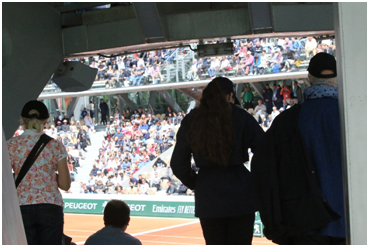VIEW AND DOWNLOAD WORLD TENNIS GAZETTE VOL. 12 NO. 2
By JOHN MARTIN

World Tennis Gazette/John Martin
PARIS — Protest vanished in praise when the 2019 French Open matches began here at the edge of the Bois de Boulogne.
A sunken tennis court named in honor of Simonne Mathieu, a 20th Century French women’s champion and war heroine, sat surrounded by four splendid greenhouses filled with plants from four continents.
“Africa to the south, Asia to the east, Oceana to the north, and the Americas to the west,” Garden Director Paul Guillou told Christopher Clarey of The New York Times.
On opening day, thousands of tennis spectators assembled and strolled at the core, walking beneath glass archways that funneled them to their seats.
Beside them, encased in glass, were some of the 500 species of flora and fauna imported from Earth’s gardens. A fine mist bathed the plants in moisture.
On court, as matches started, a sense of spectacle taking place in a sanctuary began to take hold. It was possible for a few moments to forget the strife and turmoil that preceded this day.
“We are not barbarians,” insisted Alain Riou, a top French Open official, as we spoke three years ago.
Horticultural historians had attacked the project as profane, an attack on nature, a desecration of the sacred.
Begun as a botanical shrine nearly 250 years ago under King Louis XV, the Jardin des Serres commands considerable respect from historians and horticulturalists. It also serves as a source of plants used to adorn the city’s municipal buildings.
Fearful of losing public support, French Tennis Federation officials mounted a billboard campaign. Roland Garros’s fences sprouted signs disputing arguments that history was under attack.
“Not a single flower will die,” promised one tennis federation poster.
Now, as this year’s matches unfolded and spectators grew accustomed to the new surroundings, it was impossible to say if any flowers had died because of a wonderful fact: Many glorious new flowers had arrived and been planted in a magically wonderful manner.
Naming the court in honor of Mathieu placed a special bouquet beside her name in French history. During its World War II fight against German occupation, she led women in the Free French Forces, the government in exile, and earned the Legion of Honor.
Earlier, between 1929 and 1939, she won 13 major international titles in singles and doubles, including the 1938 and 1939 French singles crowns. She reached the French women’s singles final no less than eight times in the decade before war.
Photo plaques along a path leading to the Mathieu Court describe her life and identify the regions from which the plant life was imported.
The French Tennis Federation’s long-time resolve has paid dividends, drawing praise for Tournament Director Guy Forget and Federation President Bernard Giudicelli.

World Tennis Gazette/John Martin
The Mathieu Court “would not exist without the persistence of the federation, which funded the project and now has the extra space and extra showplace it felt it needed to keep pace” with the three other grand slam tournaments, said The New York Times.
The aesthetic reviews are positive, too: The New Yorker Magazine declared the effect of sitting in the garden “sublime.” The controversy had ended well, suggested writer Gerald Marzorati, because “In the end, Paris got another greenhouse, one that ingeniously surrounds a five-thousand-seat tennis area.”
In a preview, The Telegraph’s Simon Briggs called it “a quirky idea, brilliantly executed,” and “a show stopper.”
Architectural Digest chimed in by calling it the “Most Spectacular New Stadium in Tennis.”
But the most spectacular footnote came from Tennis Magazine’s Richard Evans. He found the sunken court “beautiful” and “unique.” Ordinary praise for sure.
But then, Evans, a widely respected author and tennis historian, added this note:
“When war broke out, she (Mathieu) was in New York, ready to compete at Forest Hills in the U.S. Championships. On hearing the news, she scratched her name from the draw and sailed for home.
Not long after, she was to be found in Bournemouth on the south coast of England, having joined the Auxiliary Territorial Force. When General de Gaulle arrived to rally the Free French Forces in England, he quickly asked the tennis champion to organize a women’s division–the first such force in the history of the French Army.
“Lieutenant Mathieu promptly gathered about a hundred French female exiles who provided logistical support for de Gaulle’s forces. Later, promoted to Captain, she joined the future President of France in Algiers.She spoke little of her war time activities although many were presumed to be clandestine.
“Strange to think that Alice Marble, who had beaten Mathieu in both doubles finals at Wimbledon and Forest Hills in 1938, was operating as a spy on the Continent for the American Secret Service at the same time.”